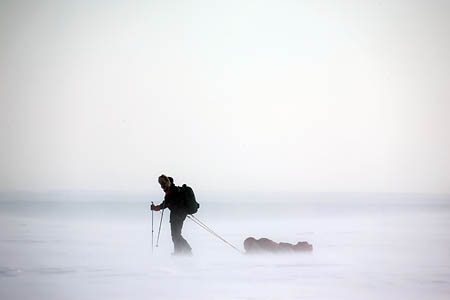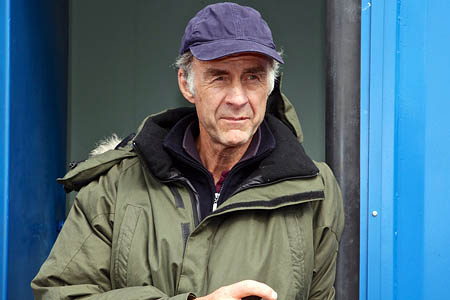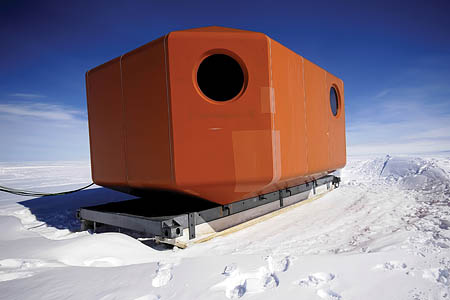On the eve of the departure of Sir Ranulph Fiennes’s expedition party for one of the most ambitious Antarctic journeys ever undertaken, more details have emerged of the equipment he and his team will use to try to keep warm in temperatures as low as –90C.
The explorer’s ship Agulhas will set sail from London tomorrow, Thursday, for the trip to the frozen continent.
Sir Ranulph, who has summited Everest and completed the North Face of the Eiger in the company of record-breaking climber Kenton Cool, will attempt the first winter crossing of the continent in near darkness.
The Coldest Journey will also attempt to raise $10m for Seeing is Believing, a global charitable initiative to fight avoidable blindness. During the sea voyage, the team will undertake a number of scientific tasks to provide unique data on marine life, oceanography and meteorology.
On 21 March 2013, the autumn equinox, the six expedition members hope to begin a six-month journey to reach the Ross Sea. Their route from the Russian base of Novolazareskaya to Captain Scott’s base at McMurdo Sound, via the South Pole, will test the limits of human endurance.
During this six-month period the expedition team will travel almost 4,000km (3,220 miles), mostly in complete darkness in temperatures as low as –90°C. The expedition team will have to be entirely self-sufficient and there will be no search and rescue facility available, as aircraft cannot penetrate inland during winter, due to darkness and risk of fuel freezing.
Previously, the furthest any expedition has ever ventured into Antarctica during the winter is 60 miles. On this journey, Sir Ranulph and his team will aim to cover 2,000 miles in six months, crossing the polar plateau at an average height of 10,000ft (3,048m) above sea level.
With a winter crossing of the Arctic having recently been completed by a Norwegian expedition, this is the first ever attempt at an Antarctic winter crossing and one of the last remaining polar challenges.
Of the Antarctic traverse, Sir Ranulph Fiennes, who will lead The Coldest Journey, said: “This will be my greatest challenge to date.
“We will stretch the limits of human endurance. Britain and the Commonwealth have a strong heritage of exploration, from Captain Cook 300 years ago to the present day. As such, it is fitting that a Commonwealth team should be the first to fulfil this last great polar expedition.
“It is a unique opportunity to carry out a number of scientific tasks in the extreme polar environment, which will make a significant contribution to our understanding of the true effects of global warming on the Antarctic continent.”
To aid him on his journey, distributor Rosker will supply the team with 6,000 packs of Hothands, a single use air-activated heat pack that will keep the team’s hands warm when the temperature gets cold.
Andi Hayman, key accounts sales manager, responsible for striking the sponsorship deal said: “This is a fantastic opportunity for us.
“We’ve known for a long time that Hothands is a great product – it will heat long after other products have stopped – clocking up 10 hours of warmth generation. This kind of staying power is exactly what the team needs for an expedition which will see temperatures plummet to as low as –90°C.”
The expedition will also be using two towable expedition cabins with British-supplied engines that will provide all the power for life essentials such as heating, lighting and cooking as well as the technical and communications work that are an integral part of the mission.
Alexis and Tony Shirtliff, managing director and chairman respectively of Westac Power, who were commissioned to build the diesel generators, said: “Sir Ranulph called us up after we were recommended by the British Antarctic Survey.
“We’ve a 15 year track record involved with the Antarctic survey so we have a proven product that has been tested in similar applications and conditions.”
The Finnings-Caterpillar tractors being used to pull the cabooses also contain special generators insulating the system and the diesel fuel supplies from the worst ravages of the Antarctic weather and problems such as waxing diesel, while also providing backup in the event of any unforeseen problems.
The power will also be driving computers that will allow more than 43,000 schools in the UK and over 100,000 schools throughout the Commonwealth access to valuable educational and interactive content, as well as being able to monitor the expedition team’s progress, allowing millions of children to take some part in the expedition
Tony Shirtliff said: “99 per cent of the parts are made in the UK.
“Britain is a physically small island but just as we’ve always produced explorers like Scott, Shackleton and Fiennes so we’ve also always produced quality engineering as well and it’s reassuring to know that even when all the polar expeditions are successfully completed there’ll still be quality British companies continuing this proud legacy.”
The Coldest Journey team will also use custom-made insulated jackets made by PHD, based in Stalybridge in Greater Manchester, and specially adapted sledge jackets made by Montane, based in Ashington, Northumberland.



MRS. EUNICE WEST.
06 December 2012APART FROM A PART OF ME THINKING SIR RANULPH MUST BE A TAD BONKERS TO ATTEMPT THIS LATEST EXPEDITION, I ADMIRE THIS INTREPID MAN. IT IS HIS ABSOLUTE FEARLESSNESS THAT IS DRIVING HIM I BELIEVE. ONE WONDERS IF HE GOT UP ONE MORNING AND THOUGHT "NOBODY HAS DONE THAT, SO I WILL HAVE A BASH AT IT"! WE CAN ONLY IMAGINE THIS JOURNEY, WHICH WILL BE UNDERTAKEN IN COMPLETE DARKNESS, - 90DEG KNOWING THERE IS NO POSSIBILITY OF AIR RESCUE OMG! THIS MAN IS BRAVE BEYOND BELIEF. I FOR ONE WISH HIM ALL THE VERY BEST. I REALLY WISH HIM WELL AND HOPE HE RETURNS GLORIOUS. I ALSO WILL SAY A PRAYER, NOT ONLY FOR HIM BUT ALSO FOR HIS WIFE AND LITTLE SEVEN YEAR OLD DAUGHTER. MAY GOD BLESS HIM AND HIS BRAVE TEAM AND BRING THEM HOME SAFE.